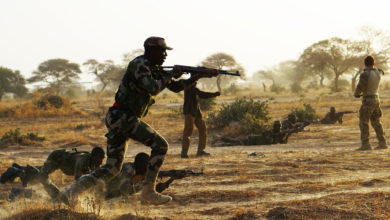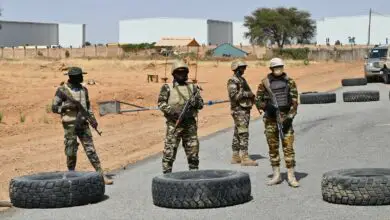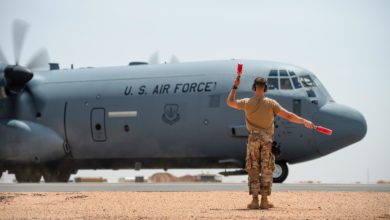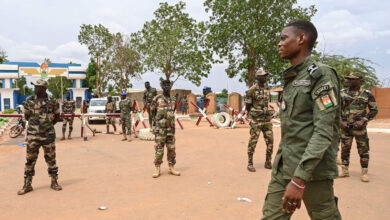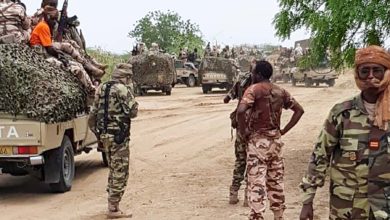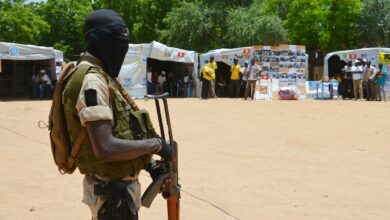An investigation into last year’s deadly assault on U.S. and local forces in Niger uncovered a series of avoidable blunders leading up to the attack, the Pentagon said Thursday.
Four American and four Nigerien troops were killed in the October 4 ambush, when scores of jihadists overran their convoy in southwestern Niger, near the Mali border.
Army Major General Roger L. Cloutier Jr., U.S. Africa Command’s chief of staff and the investigating officer; Marine Corps General Thomas D. Waldhauser, the commander of U.S. Africa Command; and Assistant Secretary of Defense for International Security Affairs Robert S. Karem, briefed Pentagon reporters on the results of the investigation.
While the Pentagon said all four U.S. soldiers fought bravely and “died with honor,” investigators found they had not been properly trained ahead of the mission and pointed to problems with how it was approved in the first place.
The U.S. soldiers, who belonged to a special operations team, had deployed to the western African nation in the autumn to conduct counter-terrorism assistance and training with the Nigerien military. Currently about 800 U.S. troops are in Niger.
But at the time of their deployment, only half of the U.S. team had conducted any collective training together, according to an eight-page summary of findings of the three-month investigation, which itself remains classified.
Their mission on October 3 was to “find/fix and, if possible, capture” a key member of Islamic State in the Greater Sahara, the summary states.
The summary does not name him but he is widely reported to have been the group’s leader, Adnan Abu Walid Sahrawi.
Update May 10 Officials said the target was was Doundoun Cheffou, suspected of involvement in the kidnapping of U.S. aid worker Jeffery Woodke, who was seized at gunpoint from his home in October 2016 in the Tahoua region.
The U.S. team commander, however, had “inaccurately characterized” the nature of the mission in order to get it approved at a lower level instead of requesting permission from battalion-level commanders based in Chad.
An air raid was thwarted by weather, and the the ground mission was unsuccessful; while reutrning to base, the convoy stopped for a water resupply near the village of Tongo Tongo. After an improptu meeting with village leaders, the team departed and were ambushed immediately south of Tongo Tongo by a large enemy force, the summary said.
The language used for the mission had been copied and pasted from previous operations and “a lack of attention to detail in quality control and quality assurance,” together with inadequate approvals “all contributed to a general lack of situational awareness and command oversight at every echelon,” the report summary states.
And prior to setting out on the operation, the U.S. team failed to conduct pre-mission rehearsals or battle drills with their Nigerien counterparts, the report found.
Eleven U.S. forces and more than 30 Nigeriens were on the mission.
Investigators found “individual, organizational and institutional failures and deficiencies that contributed to the tragic events,” but did not identify one single failure or deficiency as the sole reason.
Waldhauser told Pentagon reporters that U.S. forces are now “far more prudent” in their missions and have beefed up firepower and drone support.
“It provides adequate and more resourceful force protection measures in order to still keep up with the enemy forces on the ground,” he said.
The Pentagon officials also showed a detailed, 10-minute video reconstruction of the ambush itself, which started as the U.S.-Nigerien eight-vehicle convoy headed out the remote village of Tongo Tongo, having stopped there for water.
The troops were not even wearing body armor when the assault first started, and had to stop their convoy to don it.
Enemy fire was initially light, but quickly intensified as the militants surged through a wooded area alongside the convoy.
The video describes how the convoy was forced to split up and how it was outflanked by over 100 enemy fighters.
Officials praised the actions of the French air force, which flew Mirage jets in a low-altitude “show of force” over the jihadists.
But, because the French were not able to identify where the U.S. troops were on the ground and were unable to communicate with them, they did not engage the enemy, but the overflights caused the militants to retreat for cover, “likely saving the lives of the surviving members of the” U.S. team, the summary states.
Around five hours after the ambush began, French forces assigned to its Operation Barkhane mission arrived in two helicopters and evacuated the surviving U.S. soldiers. Nigerien reinforcements arrived later and secured the site.
Sergeant La David Johnson was among the four Americans killed, and the video shows he became separated from his comrades. Johnson’s body was not found until 48 hours after the attack.
Mattis concludes “institutional and organizational issues” must be addressed
In a statement, Pentagon Chief Spokesperson Dana White said that Defense Secretary Jim Mattis has issued a series of recommendations in light of the report, including better pre-deployment training.
“Secretary Mattis concluded there are institutional and organizational issues, not isolated to this event that must be addressed immediately by the Department of Defense,” White said.
Among other actions, Mattis “directed the Department of the Army to conduct an assessment of the training Special Forces receive and provide to partner forces, and to review its pre-deployment training to ensure that units are adequately prepared for operational requirements,” White said.
Mattis also directed U.S. Special Operations Command to review training, operating procedures, operational-level planning, and other factors relevant to the ambush.
With reporting from AFP


